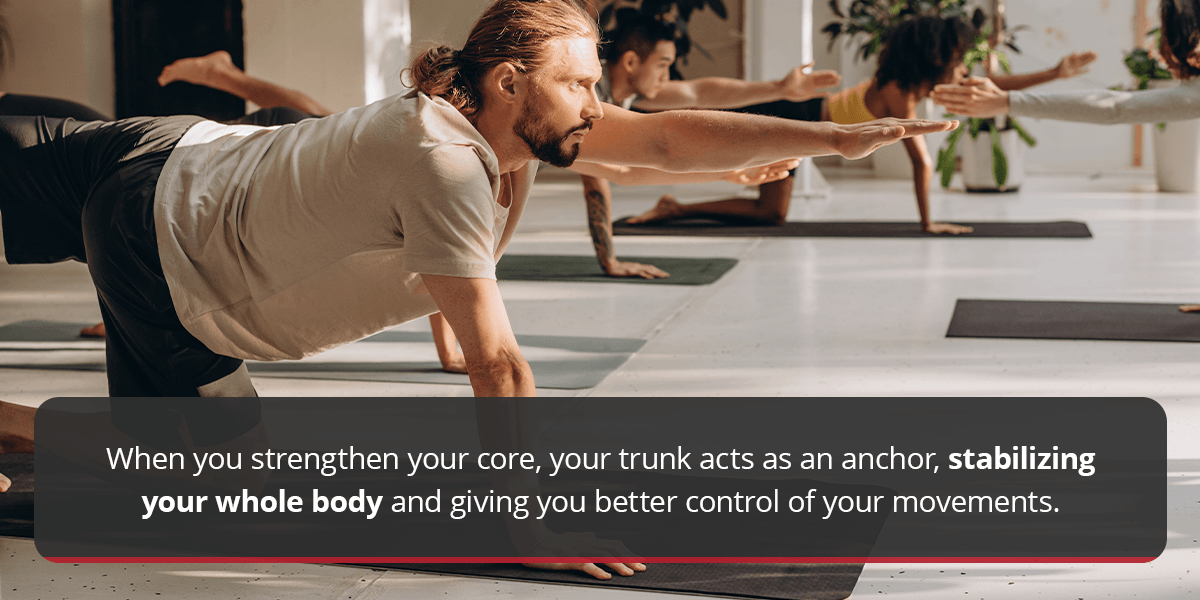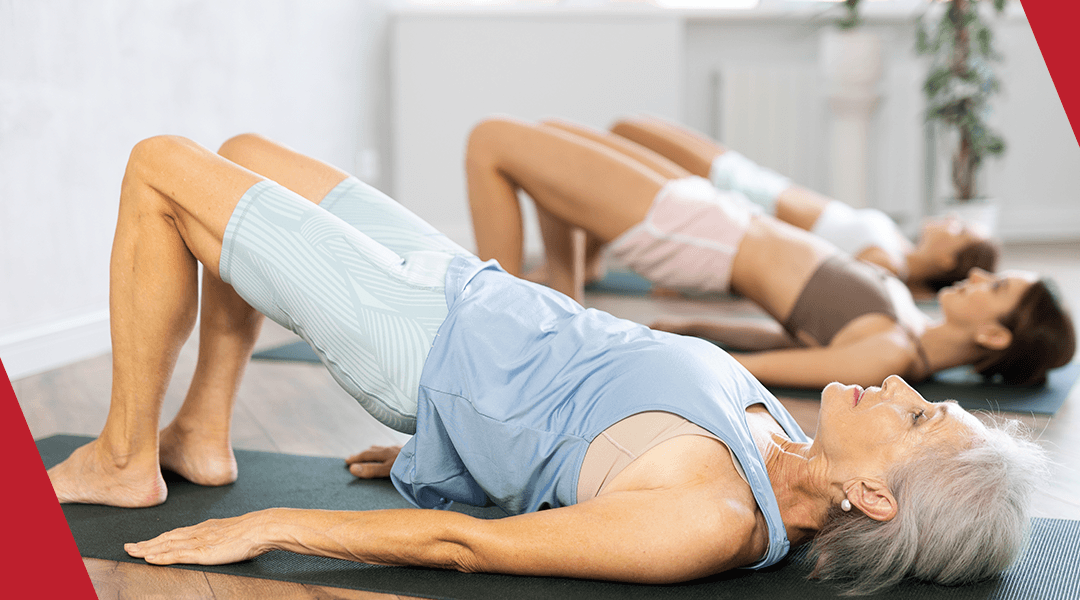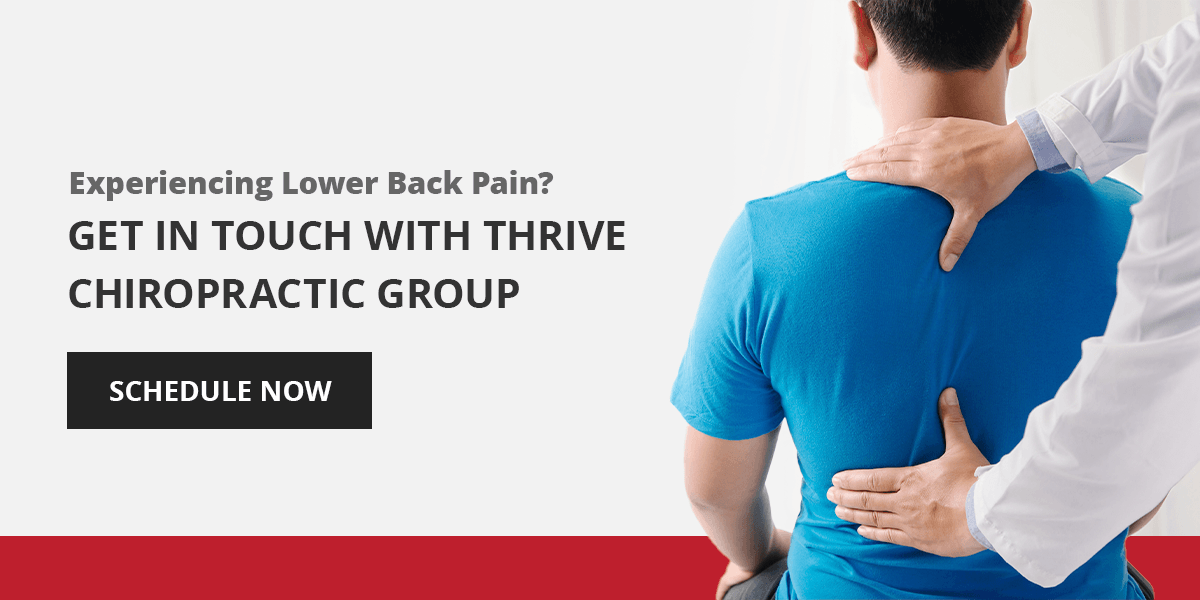Lower back pain is a common and often debilitating problem that affects millions of Americans. Up to 84% of people experience lower back pain at some point throughout life. Fortunately, there are simple, cost-effective steps you can take to ease the discomfort. Our all-in-one guide explains how to strengthen core and back muscles for pain relief and a better quality of life.
Why You Need a Strong Core and Lower Back
Your core is your body’s trunk, supporting your limbs and cervical spine like the branches of a tree. The trunk comprises four pivotal areas — your abdominal muscles in the front, gluteal and paraspinal muscles in the back, pelvic floor and hip muscles below and your diaphragm above. These muscles all work together to stabilize your spine and facilitate safe, effective movement.
A strong core protects your lower back from muscle strains, chronic inflammation, spinal injuries, sciatica and referred pain. It’s also crucial for maintaining good mental health, as back problems can disrupt sleep and cause prolonged distress. Benefits of lower back core workouts include:
1. Preventing Injuries
If your core muscles are underdeveloped, movement and gravity put pressure on more sensitive areas of the body, like the lumbar vertebrae of your lower spine, the disks between them and the nerves surrounding them. These vertebrae must stay aligned and supported for healthy bending, lifting, stretching and twisting. Strong core muscles prevent injuries and conditions such as:
- Herniated disks
- Ligament strains and tears
- Hip bursitis
- Back muscle strains
- Knee joint instability
- Falls from imbalance
2. Improving Posture
Posture is important in keeping your musculoskeletal system agile, flexible and strong. It opens up your chest for easier, more effective breathing, reduces long-term wear and tear on your joints and helps keep your spine balanced. When you strengthen your core, your trunk acts as an anchor, stabilizing your whole body and giving you better control of your movements.

3. Adding Balance and Stability
While balance is essential in sports, dance, yoga and other physical activities, it’s even more important when you’re not necessarily concentrating on your movements. You rely on balance for many day-to-day activities — from walking the dogs to standing still. Core muscles such as your obliques, transverse abdominis and erector spinae coordinate to keep you upright and secure when standing and in control when moving.
4. Enhancing Physical Performance
Whether you’re a professional athlete, work a physically demanding job or enjoy working out at the gym to keep in shape, better physical performance produces better results. Several studies have shown that a stronger core leads to better balance, motion control, energy preservation and overall improvement in athletes from various sports.
5. Minimizing Lower Back Pain
There are several types of back pain, although two of the most commonly diagnosed conditions are non-specific chronic lower back pain (cLBP) and sciatica. Sciatica happens when your sciatic nerve is compressed or injured and can cause shooting pain or “pins and needles” (paresthesia) from the lower back right down to the lower limbs. Core strengthening exercises for lower back pain can effectively reduce cLBP and manage sciatica symptoms.
The 5 Best Back and Core Exercises for Back Pain
You need to train your core and back muscles regularly to strengthen them and reduce your lower back pain. Because the core comprises so many interconnected muscles, you’ll need a few different techniques in your workout to cover all target areas. If you practice these five back pain relief stretches and exercises several times per week, you’ll boost your core strength and likely see a reduction in back pain.
What to Know Before You Start Your Lower Back Core Workout
Before you start your exercises, lay down a thin cushioning mat, wear flexible clothing, tie up loose hair and bring a towel and filled water bottle. If you can’t quite manage the suggested number of reps or feel you could do more sets, feel free to adjust for your unique abilities and goals. If you feel any acute pain or significant discomfort, stop the exercise and try another less strenuous stretch. If you’re still struggling, consult a chiropractor for diagnosis and treatment.
Bird Dog
The bird dog is an excellent low-intensity exercise to add to lower back core workouts for enhanced balance:
- Get on your hands and knees — your shoulders above your hands, your hips above your knees and your back straight.
- Focus on and engage your trunk to stabilize your spine and maintain balance while keeping your hips level, not tilted.
- Simultaneously extend your right arm and your left leg parallel to the ground, keeping them in line with your straight back.
- Hold this horizontal line for several seconds, then slowly lower your arm and leg back down to the tabletop position.
- Do the same extending motion using the opposite arm and leg, hold, lower back down and repeat eight times on each side.
Forearm Plank
Incorporate the forearm plank for a full-spectrum core workout that helps stabilize the spine:
- Get into a push-up position and lay your forearms on the floor with hands facing forward and elbows directly under your shoulders.
- Engage your core muscles to support your weight, concentrating on keeping your back straight and parallel to the ground.
- Hold this position for as long as possible, breathing deeply and regularly, and then gently lower yourself back down.
Dead Bug
The dead bug is essentially the bird dog upside down. Contrary to its amusing name, the dead bug is a life-giving pose that improves posture:
- Lie on your back, stretch your arms up toward the ceiling, and bend your knees at a 90-degree angle so your shins parallel the ground.
- Simultaneously lower your right arm above your head and straighten your left leg so your heel nearly touches the floor.
- Slowly bring your arm and leg back to the starting position, and then do the same extension with your opposite limbs.
- Repeat this movement six times on each side, keeping your core activated throughout.
Glute Bridge
With the glute bridge, you can strengthen your gluteal muscles and build hip stability:
- Lie on your back, relax your arms by your sides, bend your knees and bring your heels about a foot away from your bottom.
- Your soles should be flat on the floor, your toes facing forward, and your heels hip-width apart.
- Tighten your core and raise your hips so your shoulders, hips and knees form a straight diagonal line.
- Slowly lower your hips back down and repeat the movement 12 times.
Clamshells
Clamshells are fantastic back and core exercises for anchoring your pelvis and reducing hip and lower back pain:
- Lie on your side with your hand supporting your head and your elbow in line with your shoulder.
- With your knees and feet stacked, bend your knees at a 90-degree angle, keeping your feet in line with your hips and shoulders.
- Lift up your top knee, keeping your feet together so your legs create a diamond shape like a clamshell opening.
- Slowly lower your knee back down and repeat this movement 12 times, focusing on engaging your glutes and core.
- Switch to your other side and do the same set of 12 knee raises using your other leg.
How Often You Should Do Core Strengthening for Back Pain
You should repeat these lower back core workouts three to five times weekly with rest days for recovery. You may feel some stiffness at first, which is normal and a good sign that you’re building strength and on the road to better balance and pain relief. Studies suggest you should see significant improvement within three to nine weeks.
Experiencing Lower Back Pain? Get in Touch With Thrive Chiropractic Group
For reliable, professional help with your lower back pain, book an appointment with a chiropractor in your area. The benefits of chiropractic treatments for lower back pain include diagnostics, better sleep, increased mobility, enhanced flexibility, relief from discomfort, sciatica investigation and management and many more life-changing, science-backed advantages.
At Thrive Chiropractic Group, we believe that everyone deserves to live an active, fulfilled and pain-free life, so we constantly strive to make that a reality. Our dedicated team of expert doctors and health care professionals provides outstanding quality treatment at cost-effective prices to patients throughout southern Oklahoma City, Moore and Edmond. Learn more about how Thrive Chiropractic Group improves lives, or schedule an appointment with us today.


